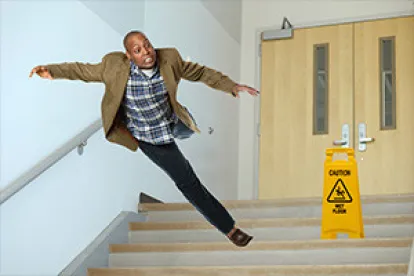You slipped, you lost your balance, and you fell down and got hurt. Does this automatically mean it is the fault of the property owner? The answer is, “Maybe.” If the property is in disrepair or the owner knew about the risk and ignored it, you could have a claim. But before you start planning on the owner paying your medical bills, you should think about the conditions of the property, the steps the owner took to prevent an accident, and whether or not those steps were reasonable. Ask yourself these questions and then call an experienced, knowledgeable attorney who can assess your options for insurance claims, or, if warranted, for a negligence claim:
Does the property owner have a duty to protect your safety?
There are three classes of people who may be owed a duty of care: invitees, licensees, and trespassers. Landlords and tenants may be subject to different rules but in general if the landlord is responsible for the safety of the area where the injury occurred, then he may face liability.
-
Invitees. The property owner owes the highest level of duty to “invitees” and must take “reasonable steps” to make sure the property is safe, including inspecting for unknown Invitees may include customers in a store or restaurant, job applicants, contractors, or park visitors.
-
Licensees. Licensees are on the property for social reasons. You are a licensee if you are visiting your friends at their home. Your friend still owes you a reasonable duty of care but only to the point of protecting you from known
-
Trespassers. Yes, even though trespassers do not have permission to be on the property, the owner owes a duty of care. In this case it’s only to the level of “ordinary” care after they become aware of the trespassers presence. Children trespassers are different. An owner has at least a duty to inspect for potentially dangerous conditions that act as “attractive nuisances,” as a swimming pool or swimming pond would. If a child is drawn there due to such nuisance the owner can liable for injuries anywhere on the property.
Should the owner reasonably have known about the condition?
Was the entrance to the building covered by ice? Was it obvious the porch was infested with termites, falling apart, or likely to collapse? Were there signs warning of danger? Or was it a hidden condition?
If there is a hidden condition or defect, a property owner can claim he didn’t know about it and can’t reasonably have been expected to know about it or fix it. If the property owner has done everything possible to keep the property safe, the fact that you fell and got injured may not be his fault. Lack of reasonable knowledge is a valid defense against a negligence claim for a slip and fall injury. To prove otherwise is a complicated process involving review of records of maintenance, past claims, and any other information that might suggest the property owner should have known and fixed the hazard.
Was the dangerous condition something the property owner should have fixed?
Did the owner delay or refuse to fix the damage? Or was the owner unaware of the need for repair?
If, for example, you lease commercial property and have repeatedly asked the landlord or building manager to fix or repair unsafe conditions in the common area, then, depending on the facts, there is a chance you can recover medical expenses and other damages if you are injured or a customer is injured. However, if you never reported the problem and/or it wasn’t reasonably apparent in an inspection, the results could be very different. Just because there is danger doesn’t mean the owner of the property is responsible for injuries.
Did the property owner cause the risky condition?
Did a waitress at the restaurant spill soda right in front of your path to the restrooms? Did the owner divert you off the sidewalks to a detour over an uneven rocky path? Or did you stumble on a flat surface because you have a bum knee?
If you are partially at fault for a fall, you may still be able to recover damages but the amount is likely to be reduced by the percentage of your contribution to the accident. Different states have different rules on how this applies. In some states if you are even 1% at fault, you are not eligible for damages. New Jersey and Pennsylvania follow a 51% rule where you must be at least 51% at fault to be blocked from recovery. If you have a bum knee and fall on a flat service, your contribution could easily be over 51%. But if you have a bum knee and the sidewalk was uneven or icy, the owner of the property may be ruled to have equal or greater percent of fault. Damages are usually reduced by your percentage of contribution to the injury.
In addition to the complicated rules around liability, there are also complex issues associated with payment of claims against more than one person or entity. In some cases, a plaintiff can recover the damage award from only one party in the case; in others they may be able to collect from any party. This may help in a case where one property owner is insolvent or can’t pay a large settlement and another party can.
The main takeaway is to understand that liability for injuries is dependent on many rules and laws that protect property owners as much as they protect people who have been injured. If you fell and were injured on someone else’s property you should contact an experienced attorney who can analyze whether or not you have a claim, and then file the claim against all parties that may be liable for your injury.



 />i
/>i

